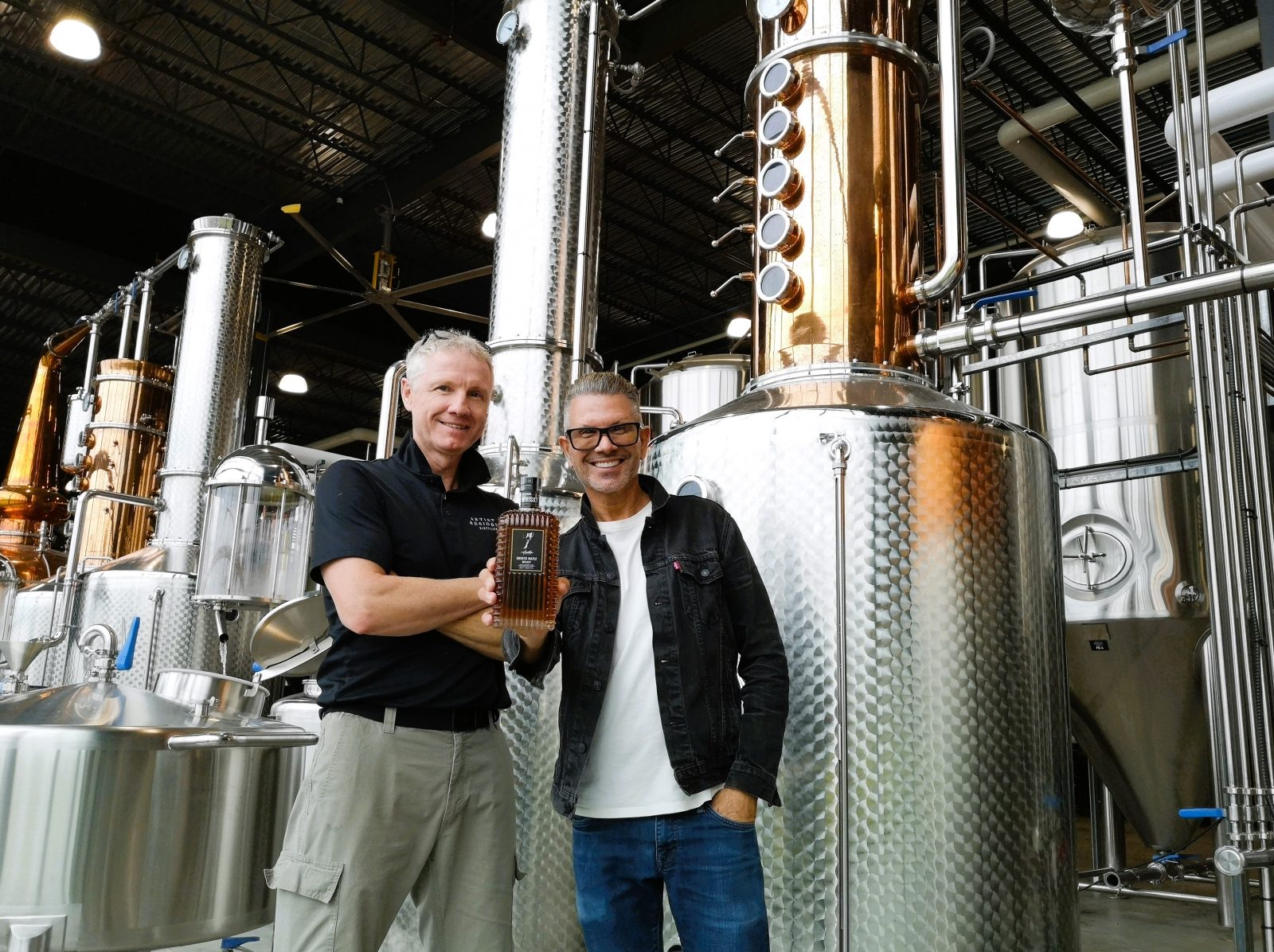Outside, the monolithic building on Tupper Street in Hawkesbury has a gleaming black aluminum and glass façade only partially obscuring shining 6,000-litre copper pot stills and other stainless steel equipment, several stories above which is the illuminated sign Artist in Residence Distillerie.
Inside the 25,000 sq.-ft. facility, sister venue to a seven-year-old Artist in Residence (AiR) Gatineau location, two brothers – Pierre and Michel Mantha – are at work making the whisky which has recently become available in area LCBO outlets.
“We launched our first beverage on October 2, our smoked maple whisky. It’s doing really well and sold out in two LCBO outlets in about 24 hours,” says Pierre.
Overseeing distilling operations, Michel watches as spent grain is augured out of the first part of the system into a plastic container about the size of a dumpster. A few metres away, “moonshine,” crystal clear and about 74 per cent alcohol by volume (ABV), is pouring from a spigot into a squat stainless-steel drum for its next stage: dilution with water to 58 per cent before being piped into barrels for aging until 2027-28. On the shelf, it will be 30 per cent ABV.
To be labelled “Canadian whisky,” as required by Canada’s “Food and Drug Act,” beverage alcohol must be mashed, distilled and aged in Canada in small wooden vessels (such as barrels) for at least three years and be at least 40% alcohol by volume: this current AiR lot will be infused as smoky maple Canadian whisky.
AiR whisky is mostly corn with relatively small percentages of barley and rye. For its part, the spent grain, sometimes known as draff, makes its way back to area farmers as cattle feed. In a way, it closes a circle that began when AiR sourced grains from those local farms.
From truck dealerships to distilling
Gatineau-born Pierre Mantha came to distilling from quite a distance, in terms of business background: he’s a truck mechanic with a two-decade history in truck dealerships, of which he’s owned several outlets.
“I’d say eight years ago, I didn’t know what gin was, what a distillery was. We had the land, so we built a distillery in Gatineau. Now we have a best-selling gin at the SAQ.”
The market for spirits – clear and brown – is erratic. Gin might be up when whisky is down; vodka could be hot as demand for London Dry is cooling. And then, along comes tequila when George Clooney gets a hold of it, and its market value across the world is likely to exceed $30 billion over the next few years.
While global beverage alcohol sales will generally grow only slowly over the next five-year period, premium craft and artisanal products – like AiR’s smoked maple whisky which sells for $35 in the LCBO – are anticipated to be more robust, according to industry analysts.
“It’s a lot of hype,” Mantha says of the spirits market. “Things change every two or three years.”
And change is what AiR anticipates.
The Tupper Street distillery is, according to mock-up designs he shows me on his phone, just the first phase: the brothers’ plans include investing in several more buildings that will cover 160,000 sq.-ft. on 15 adjacent acres they have purchased for development in Hawkesbury.
The business model is to build a distillery every three years, as well as expanding into the U.S., where they have purchased land in Pennsylvania.
“You need volume, you need to be big to survive,” he says, citing that having access to the LCBO means access to one of the world’s largest buyers of beverage alcohol; as a sidebar, there are, in fact, about 670 retail LCBOs and over 800 grocery stores, licensees and LCBO “convenience outlets.”
Distillerie in French
Size, of course, is relative. Mantha says American distillers will buy 250 acres and invest more than $200 million in their facilities. While the AiR enterprise represents millions of dollars invested, it wasn’t easy: the process got “derailed,” and there were equipment, permits and inspection details to see to.
“At one point we were six months behind in production and were supposed to start in April. It’s now October. We got hit from all angles, but it’s done. I didn’t know it would take six months, but I always plan for the worst.”
Such are the vagaries of entrepreneurship, and, as Mantha puts it, you lose “a lot of money” at first. With his business model, he estimates losing $1 million in the first year, and by the third year will be starting “to break even, maybe.”
The Manthas selected Hawkesbury for their new distillery in part because of its proximity to their Gatineau plant, giving staff a relatively quick journey to each location as needed: the Hawkesbury plant currently has three employees; the Gatineau AiR about 10.
“We got too busy in Quebec, so I said let’s build one in Ontario,” he says. “’Artists’ in Ontario drink whisky, but that’s a tougher market in Quebec.”
He says he’s counting on a sex appeal in the company name – “we have distillerie in French,” he adds – which contributes to foregrounding the craft nature of the venture.
Everyone is a local “artist”
For now, bookending the shiny, sparkling distilling equipment are 200 toasted bourbon barrels from Kentucky. There’s space for about 800 more barrels, but after that AiR will need more buildings. That has meant limiting production for the time being.
Flavoured spirits is what the Manthas are pursuing (look for a blackberry vodka in the spring of 2025). While whisky is sometimes thought of as a stodgy drink that your grandfather may have tippled, AiR is unique, says Pierre.
“Our strategy is to do something different and bring in a new crowd with flavoured whisky. The older guys aren’t going to change (from their brown spirits). They’re drinking Jack, Jameson and Crown. We’re not going to change that.”
Whatever the flavour, the AiR concept is focussed on local: local grain, local staff and a local presence in a relatively small community. The Mantha brothers consider everyone involved in their distilling to be an “artist,” in one form or another.
“I think people should support their small liquor distillery because I think in the next five years, many could close down. But we’re all ‘artists,’ from the farmer to the distiller. And when you go home, you become the artist. You decide what you want to do with the liquor.”
While the mammoth and striking Tupper Street building is clearly intended to draw attention, Mantha says it’s also designed to create a sense of local Hawkesbury pride.
“That’s why we put everything in the front, so people who come to Hawkesbury can see the barrels and the copper pots. Everybody wants local products, and everybody wants to support local.”
Food writer Andrew Coppolino lives in Rockland. He is the author of “Farm to Table” and co-author of “Cooking with Shakespeare.” Follow him on Instagram @andrewcoppolino.



